

Week 1 Critical Thinking. Core 3 - Personalized Learning. Fostering Student Connectedness: Building Relationships in the Classroom. Meaningful Feedback for Students: 5 Research-Based Tips. In recent years, research has confirmed what most teachers already knew: Providing students with meaningful feedback can greatly enhance their learning and achievement.

Professor James Pennebaker from the University of Texas at Austin has been researching the benefits of frequent testing and the feedback it leads to. He explains that in the history of the study of learning, the role of feedback has always been central: “When people are trying to learn new skills, they must get some information that tells them whether or not they are doing the right thing. Learning in the classroom is no exception. Both the mastery of content and, more importantly, the mastery of how to think require trial-and-error learning.” The downside, of course, is that not all feedback is equally effective, and it can even be counterproductive, especially if it’s presented in a solely negative or corrective way. So what exactly are the most effective ways to use feedback in educational settings? 1. 2. 3. 4. 5. Creating Self-Directed Learners – Office of Teaching & Learning.
Today’s college graduates must be able to think critically and creatively, and be able to communicate and collaborate effectively.
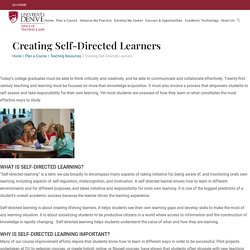
Twenty-first century teaching and learning must be focused on more than knowledge acquisition. It must also involve a process that empowers students to self assess and take responsibility for their own learning. Yet most students are unaware of how they learn or what constitutes the most effective ways to study. PL Progression v2. 5 Shifts to Learner Roles in a Personalized Learning Environment. (This article originally appeared in the AWSA Update Bulletin) by Jim Rickabaugh.
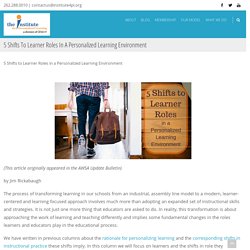
The Institute for Personalized Learning. The Institute for Personalized Learning. The Institute for Personalized Learning. The Institute for Personalized Learning. The Institute for Personalized Learning. 10 Ways to Empower Students With Choice. CAST: About Universal Design for Learning. John Hattie. Professor John Hattie is a researcher in education.
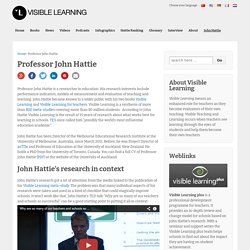
Why are so Many of our Teachers and Schools so Successful?: John Hattie at TEDxNorrkoping. Teaching Strategies that Promote Student Engagement HED. 10 Ways to Cultivate Student Engagement in Higher Education. Engaged students are those who make a firm commitment to learning.
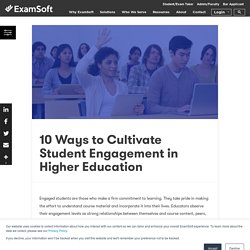
They take pride in making the effort to understand course material and incorporate it into their lives. Educators observe their engagement levels as strong relationships between themselves and course content, peers, professors, and the institution. Engagement: The Secret to Teaching Online This Fall. What Can Higher Ed Leaders Do to Support Engaging Remote Education? Focus on Student Engagement and Success This Year It’s evident that student engagement is critical to student learning and success.

Kristin Kipp, chair of education media design and technology at Rocky Mountain College of Art + Design, and Kerry Rice, a professor in the department of educational technology at Boise State University, write at EdSurge that engaged learners “demonstrate stronger satisfaction with learning experiences, stronger achievement in courses and increased graduation rates.” How do I best engage students during synchronous class sessions? Photo by Anna Shvets from Pexels You decided to offer synchronous class sessions to your students, but how do you make these lively, engaging, interactive, and worthwhile?
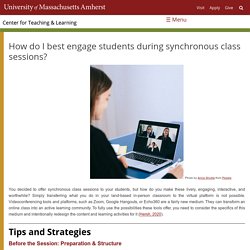
Simply transferring what you do in your land-based in-person classroom to the virtual platform is not possible. Videoconferencing tools and platforms, such as Zoom, Google Hangouts, or Echo360 are a fairly new medium. They can transform an online class into an active learning community. To fully use the possibilities these tools offer, you need to consider the specifics of this medium and intentionally redesign the content and learning activities for it (Hersh, 2020).
Before the Session: Preparation & Structure. Teaching Strategy: Connect, Extend, Challenge. The Ultimate Guide to Choice Boards and Learning Menus. The What, Why and How of Protocols. Why Use a Protocol (1) How To Create Learning Playlists In A Textbook World. How To Create Learning Playlists by Terry Heick The idea of playlists became popular with the explosion of iTunes and YouTube in the last decade.
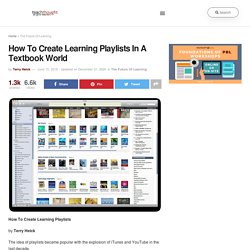
Before music became digital, it was bound by its physical restrictions. Playlists: A Path to Personalizing Learning – Dr. Catlin Tucker. One reason I am such a big advocate for blended learning is that using the various models allow me to spend more time on the aspects of my job that I enjoy and feel are most valuable for students.
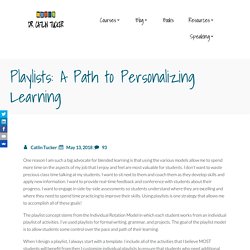
I don’t want to waste precious class time talking at my students. I want to sit next to them and coach them as they develop skills and apply new information. I want to provide real-time feedback and conference with students about their progress. I want to engage in side-by-side assessments so students understand where they are excelling and where they need to spend time practicing to improve their skills. Using playlists is one strategy that allows me to accomplish all of these goals! The playlist concept stems from the Individual Rotation Model in which each student works from an individual playlist of activities. When I design a playlist, I always start with a template.
My playlists mix the following elements: Playlists pull together a mix of activities designed to build specific skills. KWL Chart handout v.final. Teaching Strategy: K-W-L Charts. The Open Learning & Teaching Collaborative. At the Open Learning & Teaching Collaborative at Plymouth State University, we have developed the ACE Framework to guide our decision-making and professional development planning.

ACE stands for Adaptability, Connection, and Equity. TPACK.ORG. SAMR. Spark Motivation in Your Students with Success Criteria. Think about a time when you were learning something. Did you know where you were going in the learning progression? Did you understand the outcome? Nancy Frey, Douglas Fisher, Olivia Amador, and Joseph Assof (2018), authors of The Teacher Clarity Playbook, compare learning and outcomes to a pilot flying a plane. “Imagine getting into an airplane that was being flown by a pilot who didn’t know where he or she was headed. Rather, a control tower would contact her at some unspecified time in the future to let her know she had arrived, or worse, that she missed the mark entirely. Course-Evaluation-Checklist-v2.0. Ristrat.pd.reading.summ. Personalized Learning: What It Really Is and Why It Really Matters. The authors offer a framework—based on three years of campus visits—for thinking about (1) the circumstances under which personalized learning can help students and (2) the best way to evaluate the real educational value for products that are marketed under the personalized learning banner.
Let's be honest: as an academic term of art, personalized learning is horrible. It has almost no descriptive value.